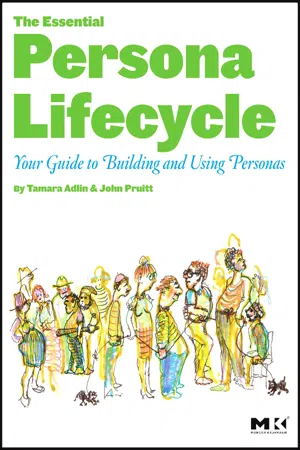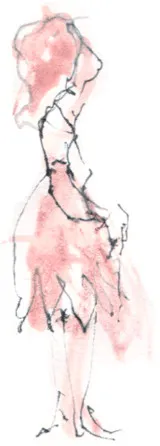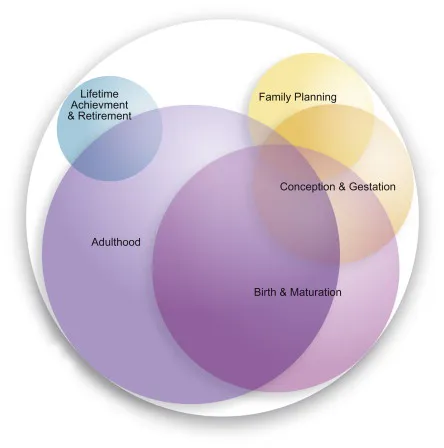
eBook - ePub
The Essential Persona Lifecycle
Tamara Adlin, John Pruitt
This is a test
Share book
- 240 pages
- English
- ePUB (mobile friendly)
- Available on iOS & Android
eBook - ePub
The Essential Persona Lifecycle
Tamara Adlin, John Pruitt
Book details
Book preview
Table of contents
Citations
About This Book
The Essential Persona Lifecycle: Your Guide to Building and Using Personas offers a practical guide to the creation and use of personas, which can help product designers, their team, and their organization become more user focused. This book is for people who just need to know what to do and what order to do it in. It is completely focused on practical tools and methods, without much explanation on why the particular tool or method is the right one.
The book discusses the five phases of persona lifecycle:
- Family planning — Basic ideas and a few tools that will help one get organized
- Conception and gestation — Step-by-step instructions to move from assumptions to completed personas
- Birth and maturation — Strategic techniques to get the right information about ones personas out to ones your teammates at the right time
- Adulthood — Specific tools that will ensure that ones personas are used by the right people at the right times and in the right ways during the product development cycle
- Lifetime achievement and retirement — Basic ideas and a few tools to you measure the success of the persona effort and prepare for the next one
- Practical and immediately applicable how-to reference guide for building and using personas – from planning, creating, launching, evaluating, and determining ROI
- Invaluable guide that gives you a quick reference for incorporating personas into a product development process
- Features all the essential how-to material from its parent book, The Persona Lifecycle, as a quick, at your fingertips companion
Frequently asked questions
How do I cancel my subscription?
Can/how do I download books?
At the moment all of our mobile-responsive ePub books are available to download via the app. Most of our PDFs are also available to download and we're working on making the final remaining ones downloadable now. Learn more here.
What is the difference between the pricing plans?
Both plans give you full access to the library and all of Perlego’s features. The only differences are the price and subscription period: With the annual plan you’ll save around 30% compared to 12 months on the monthly plan.
What is Perlego?
We are an online textbook subscription service, where you can get access to an entire online library for less than the price of a single book per month. With over 1 million books across 1000+ topics, we’ve got you covered! Learn more here.
Do you support text-to-speech?
Look out for the read-aloud symbol on your next book to see if you can listen to it. The read-aloud tool reads text aloud for you, highlighting the text as it is being read. You can pause it, speed it up and slow it down. Learn more here.
Is The Essential Persona Lifecycle an online PDF/ePUB?
Yes, you can access The Essential Persona Lifecycle by Tamara Adlin, John Pruitt in PDF and/or ePUB format, as well as other popular books in Informatique & Sciences générales de l'informatique. We have over one million books available in our catalogue for you to explore.
Information
Topic
InformatiqueCHAPTER 1
What are personas?
CHAPTER OUTLINE
Introduction
Why a Persona Lifecycle?
The Five Phases of the Persona Lifecycle
Why Another Persona Book?
What Additional Materials Will I Find in the Original Persona Lifecycle Book?
INTRODUCTION
Personas are fictitious, specific, concrete representations of target users. The notion of personas was created by Alan Cooper and popularized in his book The Inmates Are Running the Asylum: Why High Tech Products Drive Us Crazy and How to Restore the Sanity (Sams Publishing, 1999). Personas put a face on the user—a memorable, engaging, and actionable image that serves as a design target. They convey information about users to your product team in ways that other artifacts cannot.
Personas have many benefits:
• Personas make assumptions and knowledge about users explicit, creating a common language with which to talk about users meaningfully.
• Personas allow you to focus on and design for a small set of specific users (who are not necessarily like you), helping you make better decisions.
• Personas engender interest and empathy toward users, engaging your team in a way that other representations of user data cannot.
In other words, personas will help you, your team, and your organization become more user focused.

WHY A PERSONA LIFECYCLE?
We originally wrote The Persona Lifecycle: Keeping People in Mind Throughout Product Design because lots of people were excited about personas, but:
• No one had described, in practical terms, how to create personas.
• No one had described specific tools for using personas during a product development process.
• Practitioners who had tried personas had failed in their efforts more often than they had succeeded.
We looked into why so many persona efforts were failing, and we found four common reasons:
1. The effort was not accepted or supported by the leadership team.
2. The personas were not credible and not associated with methodological rigor and data.
3. The personas were poorly communicated.
4. The product design and development team employing personas did not understand how to use them.
The Persona Lifecycle was a solution: an end-to-end set of methods and tools designed to support persona practitioners from the moment they decided to try personas until well after the completion of a project. The persona lifecycle is built on several core assertions, all of which arose from our research and experience:
• Building personas from assumptions is good; building personas from data is much, much better.
• Personas are not documents. They are shared ideas around who your users are that must come to life in the minds of the people in your organization.
• Personas are a highly memorable, inherently usable communication tool if they are communicated well.
• Personas can be initiated by executives or first used as part of a bottom-up grass-roots experiment, but eventually they require support at all levels of an organization.
• As long as personas are well built, data driven (or otherwise validated and agreed upon), and thoughtfully communicated, the product team can use the personas that come to exist to generate new insights and seek out the right details when they need them.
• Personas are not a stand-alone, user-centered design (UCD) process but should be integrated into existing processes and used to augment existing tools.
• Effective persona efforts require organizational introspection and strategic thinking.
• Personas can be created and show their value quickly, but if you want to obtain the full value from personas you will have to commit to a significant investment of time and resources.
We understand that the devil is in the details when it comes to launching a persona effort within an organization, and we are excited to share specific techniques that will help you succeed in your own persona efforts and in turn help your organization realize the benefits of truly UCD.
The five phases of the persona lifecycle
The persona lifecycle is a metaphoric framework that breaks the persona process into phases similar to those of human procreation and development. As shown in Figure 1.1, the five phases in this framework bring structure to the potentially complicated process of persona creation and highlight critical (yet often overlooked or ignored) aspects of persona use:
• Family planning—Before you begin any persona effort, you should figure out what problems you’re trying to solve and what materials (specifically, data sources) are already available for you to use.
• Conception and gestation—Organize assumptions; turn data into information and information into personas.
• Birth and maturation—Create a persona campaign and introduce the personas to your organization.
• Adulthood—Use the personas in specific ways to help during the design, development, evaluation, and release of your product.
• Lifetime achievement and retirement—Measure the success of the persona effort and create a plan to reuse or retire the personas.

FIGURE 1.1
The five phases of the persona lifecycle. This diagram is designed to show both the order of the phases (from family planning through conception and gestation, birth and maturation, adulthood, and finally lifetime achievement and retirement) and the relative amount of effort and importance related to each phase. Each lifecycle phase is covered in detail in subsequent chapters of this book.
As the name indicates, the persona lifecycle is a cyclical, largely serial, process model. As Figure 1.1 shows, each stage builds on the next, culminating but not ending at the adulthood phase. Note also that the final stage, lifetime achievement and retirement, is not immediately followed by a cyclical return to the first stage. This is because different persona efforts culminate and restart in different ways. Personas can be reused, reincarnated, or retired depending on the project.
More importantly, although each phase does build on the previous, some are more important than others, and some you can complete in just an hour or two if need be. Conception and gestation and adulthood are the vital steps. As you read this book, remember that you can (and should) customize your own persona process in accordance with the amount of time, resources, and data you have.
The persona lifecycle doesn’t have to take a long time. You can, and should, be selective in the techniques you choose to integrate into your persona effort. Although we do not think it is a good idea to skip any of the lifecycle phases completely, we do believe it is completely acceptable to take some shortcuts within any of the phases. Giving some attention to every phase will increase the odds that your persona effort will ultimately be successful. Your overall goal should be to create helpful and well-used personas, not to follow the process described in this book to the letter. Throughout the book, we suggest both complete end-to-end processes and helpful shortcuts. We point out the processes we believe to be the most important and effective, and you can treat each chapter as a menu of techniques and tools that can be used together or independently.
WHY ANOTHER PERSONA LIFECYCLE BOOK?
The original version of The Persona Lifecycle: Keeping People in Mind Throughout Product Design is rich in details, examples, philosophy, and stories from the field. It was written to give you the full context around every aspect of persona creation, communication, and use, in addition to as many tools and tricks as we could find. The original is a reference tome that will help practitioners navigate the specific needs of their own orga...